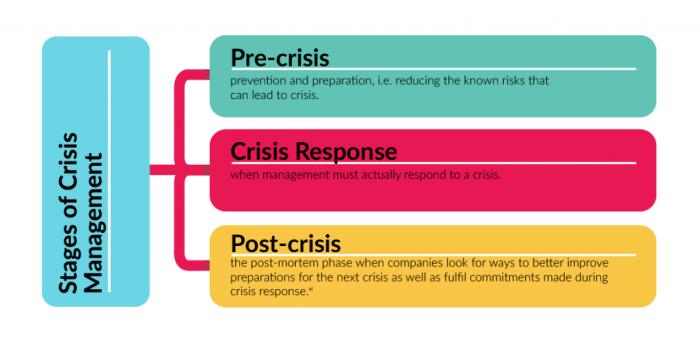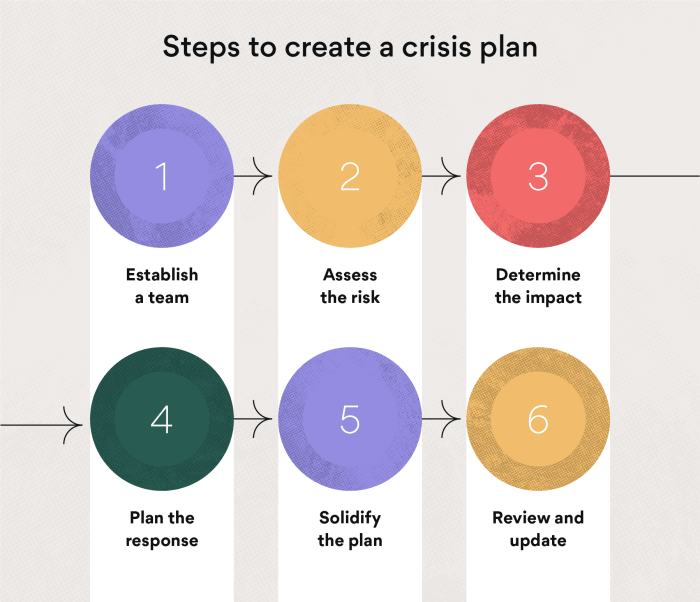Developing a Crisis Management Plan sets the stage for proactive strategies to handle unexpected challenges, ensuring business resilience and continuity. Dive into the key elements of crisis management and discover how to navigate through turbulent times with confidence.
In this guide, we will explore the essential components of crisis management, from risk assessment and preparedness to communication strategies and continuous improvement, empowering you to effectively tackle unforeseen circumstances.
Understanding Crisis Management
Crisis management is the process of preparing for, responding to, and recovering from a crisis or unexpected event that threatens an organization. It is crucial for businesses, schools, and other entities to have a well-thought-out plan in place to handle crises effectively.
Key Components of a Crisis Management Plan
- Establishing a crisis management team with defined roles and responsibilities.
- Identifying potential crises and developing response protocols for each scenario.
- Creating communication strategies to ensure timely and accurate information is shared internally and externally.
- Conducting regular training and drills to prepare staff for crisis situations.
Benefits of a Well-Developed Crisis Management Plan, Developing a Crisis Management Plan
- Minimizing the impact of a crisis on operations, reputation, and finances.
- Protecting the safety and well-being of employees, customers, and stakeholders.
- Enhancing overall organizational resilience and preparedness for future emergencies.
- Building trust and credibility with the public by demonstrating effective crisis response.
Risk Assessment and Preparedness

When it comes to managing crises, one of the key steps is conducting a thorough risk assessment. This process allows businesses to identify potential threats and vulnerabilities that could lead to a crisis situation. By understanding these risks, organizations can better prepare and respond effectively when a crisis occurs.
Identifying Potential Crises
- One way to identify potential crises is to conduct a SWOT analysis, which looks at the company’s strengths, weaknesses, opportunities, and threats.
- Monitoring industry trends and news can also help businesses anticipate potential crises that may arise.
- Engaging with stakeholders and employees to gather insights on possible risks and vulnerabilities is another important method.
Preparing for Various Types of Crises
- Developing a comprehensive crisis management plan that Artikels roles, responsibilities, and communication strategies is crucial.
- Conducting regular drills and simulations to test the effectiveness of the plan and ensure all employees are familiar with crisis protocols.
- Establishing relationships with key external partners, such as media outlets, government agencies, and industry associations, can help facilitate a coordinated response during a crisis.
Crisis Response Team
In times of crisis, having a well-prepared crisis response team is crucial to effectively manage and mitigate the impact of the situation. The team consists of individuals with specific roles and responsibilities that work together to ensure a coordinated response.
Roles and Responsibilities
- The Crisis Manager: Leads the team, makes critical decisions, and coordinates all response efforts.
- Communications Coordinator: Manages internal and external communication, ensuring accurate and timely updates are provided.
- Operations Director: Oversees the implementation of response plans and ensures resources are allocated effectively.
- Subject Matter Experts: Provide specialized knowledge and guidance related to the specific crisis at hand.
- Support Staff: Assist in various tasks such as logistics, documentation, and support services for affected individuals.
Examples of a Well-Structured Crisis Response Team
A well-structured crisis response team could consist of a Crisis Manager with experience in crisis management, a Communications Coordinator with strong public relations skills, an Operations Director with logistical expertise, subject matter experts from relevant departments, and support staff trained in emergency response protocols.
Importance of Clear Communication
Clear communication within the crisis response team is essential to ensure that all members are on the same page, understand their roles, and can effectively coordinate their efforts. It helps in avoiding confusion, preventing misinformation, and streamlining decision-making processes for a more efficient response.
Communication Strategies
Effective communication is crucial during a crisis to ensure that accurate information is disseminated timely and efficiently. It helps in managing the situation effectively, reassuring stakeholders, and maintaining transparency. Different communication strategies play a vital role in crisis management, including communicating with employees, stakeholders, and the public, as well as utilizing social media platforms.
Internal Communication
Internal communication within an organization is essential during a crisis to keep employees informed, address concerns, and maintain morale. It is important to have a structured communication plan in place to ensure that employees receive updates regularly. Utilizing various channels such as emails, internal newsletters, and intranet platforms can help in conveying information effectively to all employees.
- Hold regular virtual meetings or town halls to update employees on the situation and address any queries or concerns.
- Establish a designated communication team responsible for disseminating information internally and ensuring consistency in messaging.
- Encourage two-way communication where employees can provide feedback or ask questions to stay engaged and informed.
- Provide resources and support for employees to cope with the crisis, such as mental health resources or remote work guidelines.
External Communication
External communication involves engaging with stakeholders, partners, and the public to provide updates, address concerns, and maintain trust in the organization. Clear and transparent communication is key to managing external relationships during a crisis.
- Designate a spokesperson or communication team to handle external communications and ensure a consistent message is delivered.
- Utilize press releases, media statements, and social media updates to provide timely information to the public and stakeholders.
- Establish communication channels for stakeholders to reach out with questions or concerns, such as a dedicated hotline or email address.
- Monitor media coverage and social media conversations to address any misinformation or rumors promptly.
Role of Social Media
Social media plays a significant role in crisis communication by providing a platform to reach a wide audience quickly. Organizations can leverage social media to disseminate information, respond to inquiries, and address concerns during a crisis.
Social media platforms like Twitter, Facebook, and LinkedIn can be used to provide real-time updates, share resources, and engage with stakeholders directly.
- Monitor social media channels for mentions of the organization and the crisis situation to stay informed about public perception and concerns.
- Respond to comments, messages, and inquiries promptly to demonstrate transparency and address any misinformation circulating online.
- Use social media to showcase the organization’s efforts in managing the crisis, such as relief efforts, safety measures, and employee support initiatives.
- Collaborate with influencers or partners to amplify messaging and reach a larger audience during a crisis.
Training and Simulation Exercises: Developing A Crisis Management Plan
Training employees for crisis situations is crucial for ensuring they are prepared to handle unexpected events effectively. By providing them with the necessary knowledge, skills, and resources, organizations can minimize the impact of crises and protect both their employees and their reputation.Simulation exercises play a key role in testing the crisis management plan as they allow organizations to simulate realistic crisis scenarios and evaluate the response of their crisis management team.
These exercises help identify gaps in the plan, improve coordination among team members, and enhance decision-making under pressure.
Examples of Successful Crisis Simulation Exercises
- In a simulated cyber-attack scenario, a company’s IT team successfully contained the breach, restored systems, and communicated effectively with stakeholders to maintain trust and transparency.
- During a tabletop exercise on a natural disaster, a government agency efficiently coordinated with local authorities, first responders, and community organizations to ensure a swift and coordinated response to the crisis.
- A multinational corporation conducted a crisis simulation involving a product recall, testing their communication strategies, supply chain resilience, and customer support systems to ensure a swift and effective response in case of a real-life crisis.
Continuous Improvement

Regular reviews and updates of the crisis management plan are essential to ensure its effectiveness in handling different types of crises. By continuously evaluating and refining the plan, organizations can adapt to new challenges and enhance their response capabilities.Feedback from past crises plays a crucial role in improving the crisis management plan. Analyzing the strengths and weaknesses of previous responses can provide valuable insights into what worked well and what needs to be adjusted.
This feedback helps in identifying areas for improvement and implementing necessary changes to enhance the overall preparedness.
Strategies for Continuous Improvement
- Conducting post-crisis debriefings with the crisis response team to gather feedback and lessons learned.
- Regularly updating contact information, emergency procedures, and communication protocols based on feedback and emerging best practices.
- Engaging in scenario-based training exercises to simulate different crisis scenarios and test the effectiveness of the plan.
- Seeking input from external experts or consultants to provide fresh perspectives and recommendations for improvement.
- Establishing a mechanism for ongoing monitoring and evaluation of the crisis management plan to ensure it remains up-to-date and relevant.
